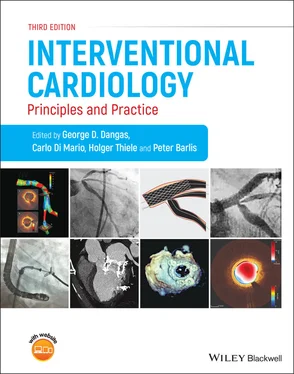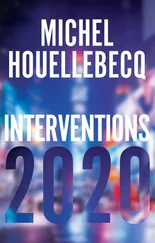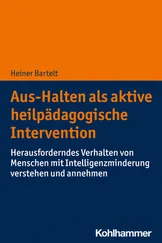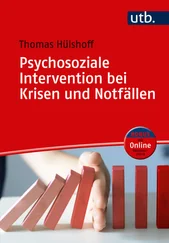Interventional Cardiology
Здесь есть возможность читать онлайн «Interventional Cardiology» — ознакомительный отрывок электронной книги совершенно бесплатно, а после прочтения отрывка купить полную версию. В некоторых случаях можно слушать аудио, скачать через торрент в формате fb2 и присутствует краткое содержание. Жанр: unrecognised, на английском языке. Описание произведения, (предисловие) а так же отзывы посетителей доступны на портале библиотеки ЛибКат.
- Название:Interventional Cardiology
- Автор:
- Жанр:
- Год:неизвестен
- ISBN:нет данных
- Рейтинг книги:4 / 5. Голосов: 1
-
Избранное:Добавить в избранное
- Отзывы:
-
Ваша оценка:
- 80
- 1
- 2
- 3
- 4
- 5
Interventional Cardiology: краткое содержание, описание и аннотация
Предлагаем к чтению аннотацию, описание, краткое содержание или предисловие (зависит от того, что написал сам автор книги «Interventional Cardiology»). Если вы не нашли необходимую информацию о книге — напишите в комментариях, мы постараемся отыскать её.
Interventional Cardiology
Interventional Cardiology
Interventional Cardiology — читать онлайн ознакомительный отрывок
Ниже представлен текст книги, разбитый по страницам. Система сохранения места последней прочитанной страницы, позволяет с удобством читать онлайн бесплатно книгу «Interventional Cardiology», без необходимости каждый раз заново искать на чём Вы остановились. Поставьте закладку, и сможете в любой момент перейти на страницу, на которой закончили чтение.
Интервал:
Закладка:
10 PART II: Interventional Pharmacology CHAPTER 38: Basics of Antiplatelet and Anticoagulant Therapy for Cardiovascular Disease Role of platelets and coagulation factors in thrombus formation Overview of antiplatelet agents for atherosclerotic diseases Phosphodiesterase inhibitors PAR‐1 antagonists Other novel antiplatelet agents Overview of anticoagulant agents for atherosclerotic diseases Thrombin inhibitors Factor Xa inhibitors Other anticoagulants under clinical development Conclusions DisclosuresReferences CHAPTER 39: Oral Antiplatelet Agents in Percutaneous Coronary Intervention Introduction Platelet activation: pathophysiology and pharmacotherapeutic targets Oral antiplatelet agents: pharmacology Oral antiplatelet therapy and PCI Duration of dual antiplatelet therapy Bleeding risk score and antiplatelet therapy Other considerations Clinical guidelines: oral antiplatelet therapy in PCI ConclusionReferences CHAPTER 40: Parenteral Anticoagulant Agents in PCI Heparin Low molecular weight heparin Direct thrombin inhibitors Factor Xa inhibitorsReferences CHAPTER 41: Vasoactive and Antiarrhythmic Drugs During PCI Introduction Vasodilators during percutaneous coronary intervention Antiarrhythmic drugs in percutaneous coronary intervention Peri‐procedural sedation Which drugs should be held before percutaneous coronary intervention Vasopressors and inotropes during PCI ConclusionsReferences CHAPTER 42: Triple Antiplatelet Therapy and Combinations with Oral Anticoagulants after Percutaneous Coronary Intervention Introduction Platelet activation and the pathophysiology of arterial thrombosis Mechanisms of antithrombotic pharmacotherapy Triple antiplatelet therapy (TAPT) following PCI Antiplatelet combinations with oral anticoagulants (OACs) following PCI vitamin K antagonists (VKAs) Non‐vitamin K antagonist oral anticoagulants (NOACs) Achieving improved outcomes following PCI: a role for a third agent? Triple antithrombotic therapy following PCI with prior indications for OAC Non‐vitamin K antagonist oral anticoagulants (NOACs) Clinical guidelines: DAPT in combination with OAC in AF Unanswered questions and future perspectives ConclusionReferences CHAPTER 43: Balance of Ischemia and Bleeding in Selecting Intensity and Duration of Antithrombotic Regimens Introduction Definitions of common ischemic and bleeding endpoints Prognostic impact of ischemic or bleeding events Risk assessment tools for ischemic and bleeding events Antithrombotic strategies to reduce ischemic and bleeding complications ConclusionsReferences CHAPTER 44: Secondary Prevention of Atherosclerotic Cardiovascular Disease Introduction Lipid management Blood pressure medications: Lifestyle management Diabetes management Future therapies ConclusionsReferences CHAPTER 45: Peri‐procedural Platelet Function Testing in Risk Stratification and Clinical Decision Making Initial evidence for HPR to ADP as a risk factor HPR cut‐off values defined by receiver operating characteristic curve analysis Randomized trials of platelet function testing Platelet function testing: bleeding saving focus Relation between low on‐treatment platelet reactivity and bleeding: the therapeutic window concept HPR in patients with STEMI during prasugrel and ticagrelor therapy Conclusions DisclosuresReferences CHAPTER 46: Monitoring and Reversal of Anticoagulation and Antiplatelet Agents Antiplatelet agents P2Y 12receptor blockers Glycoprotein (GP) IIb/IIIa inhibitors Anticoagulants Indirect thrombin inhibitors Low molecular weight heparin (enoxaparin) Pentasaccharides: Fondaparinux Direct thrombin inhibitors: bivalirudin, argatroban, dabigatran Vitamin K dependent oral anticoagulants Non‐vitamin K Oral Anticoagulants (NOACs) Idarucizumab Andexanet AlfaDisclosures References
11 PART III: Hypertension and Structural Heart Disease SECTION I: Systemic and Pulmonary Hypertension CHAPTER 47: Right Heart Catheterization and Pulmonary Hemodynamics Balloon‐tipped pulmonary artery catheter (PAC) Patient preparation, venous access, and technique Pulmonary hemodynamics Pharmacologic drug testing Cardiac tamponade Constrictive pericarditis Permanent PA–pressure monitoringReferences CHAPTER 48: Treatment of Pulmonary Embolism Risk stratification and patient selection Therapies for acute PE Medical therapy ConclusionsReferences CHAPTER 49: Renal Denervation for Resistant Hypertension Resistant hypertension Rationale of targeting the renal sympathetic nervous system Surgical sympathetic denervation Percutaneous denervation The procedure The future Renal denervation beyond hypertensionReferences SECTION II: Structural Heart Interventions CHAPTER 50: Antithrombotic Strategies in Valvular and Structural Heart Disease Interventions Rationale for antithrombotic therapy post‐TAVR Anti‐thrombotic strategies in the periprocedural period Anti‐thrombotic strategies in transcatheter‐based mitral, tricuspid, and pulmonic valve interventions ConclusionReferences CHAPTER 51: Alcohol Septal Ablation for Hypertrophic Obstructive Cardiomyopathy Introduction Selection of patients Mechanisms of treatment efficacy The technique Treatment efficacy Adverse events Future directions ConclusionsReferences CHAPTER 52: Left Atrial Appendage Exclusion Indications for LAA exclusion Endocardial devices: design and technical details Procedural aspects for implantation The Lariat system: a combined endocardial–epicardial approach Post‐implantation consideration and follow‐upReferences CHAPTER 53: Cryptogenic Stroke, Patent Foramen Ovale, and ASD Closure Types of ASD and PFO Cryptogenic stroke and its relation to PFO Atrial septal defect Closure of ASD and PFO Contraindications to ASD and PFO closure Technique ASD and PFO closure procedure ASD sizing ASD device selection PFO device selection Device delivery Completing the procedure Adverse events Aftercare Future directionsReferences CHAPTER 54: Paravalvular Leak Closure and Ventricular Septal Defect Closure Transcatheter paravalvular leak closure Transcatheter VSD closureReferences SECTION III: Valvular Heart Disease Interventions CHAPTER 55: Aortic Valvuloplasty and Large‐Bore Percutaneous Arterial Access Basic principles and mechanisms of action Indications and evidence for use Patient selection and contraindications to BAV Approach to the procedure Pre‐access considerations Large‐bore arterial access Access planning Sheath selection Pre‐closure Pre‐closure Technique Steps Contralateral safety wire Performing balloon aortic valvuloplasty Anticoagulation during BAV Crossing the aortic valve Wires BAV balloons Pacing Procedural conclusion Arteriotomy closure and troubleshooting Complications of BAV and their management Conclusions, recommendations, and future directionsReferences CHAPTER 56: Balloon‐expandable Transcatheter Aortic Valve Replacement The Edwards Sapien valve system The MyVal Valve SystemReferences CHAPTER 57: Self‐Expanding Transcatheter Aortic Valve Replacement and Cerebral Embolic Protection Introduction Evolut R/PRO/PRO+ Major trials Latest valve Procedural planning ACURATE neo(2) valve system Portico valve JenaValve/J Valve Cerebral embolic protection Conclusions DisclosuresReferences CHAPTER 58: Leaflet Modification Technologies Introduction Leaflet modification for aortic valve interventions Leaflet modification for transcatheter mitral valve replacement Conclusions DisclosuresReferences CHAPTER 59: Peri‐procedural Complications of TranscatheterAortic Valve Replacement (TAVR) Introduction Paravalvular leak Annular rupture Aortic and ventricular injuries Transcatheter valve embolization Coronary obstruction Stroke Pacemaker implantation ConclusionsReferences CHAPTER 60: Intensive Care after Transcatheter Aortic Valve Replacement Overview of the TAVR patient population Objectives of intensive care after TAVR Transition to intensive care: hand‐over Structure of post‐TAVR care Acute hemodynamic changes and disorders of blood pressure Acute anemia and bleeding Vascular complications Stroke Conduction abnormalities Atrial fibrillation Acute kidney injury Hematologic abnormalities Mobilization and progression of care Future directions for post‐TAVR intensive careReferences CHAPTER 61: New Aortic Valve Technologies SAPIEN 3 Ultra TM Evolut PRO TM ACURATE neo THV Portico Allegra THV ConclusionsReferences CHAPTER 62: Principles of Carpentier’s Reconstructive Surgery in Degenerative Mitral Valve Disease Pathophysiology and functional classification Surgical indications Principles of mitral valve surgery ResultsReferences CHAPTER 63: Transseptal Puncture Introduction Embryology and anatomy of interatrial septum: Training Echocardiographic guidance Know your equipment Specificities in transseptal puncture Complications ConclusionsReferences CHAPTER 64.1: Transcatheter Mitral Valve Repair Introduction MitraClip system (Abbot, Santa Clara, CA, USA) Anatomic caveats and eligibility criteria Mitral valve edge‐to‐edge repair Complications Primary (Degenerative) MR Secondary (Functional) MR Emerging technologies for the percutaneous treatment mitral valve disease ConclusionsReferences CHAPTER 64.2: Transcatheter Mitral Valve Replacement Introduction General principles and challenges with TMVR Preprocedural evaluation and imaging‐based procedural guidance Transcatheter mitral valve‐in‐valve and valve‐in‐ring replacement Treatment of native mitral valve regurgitation Transcatheter mitral valve‐in‐MAC replacement ConclusionsReferences CHAPTER 65: Balloon Mitral Valvuloplasty Anatomic considerations Balloon mitral valvuloplasty Indications and recommendations for percutaneous balloon mitral valvuloplasty Class IIb recommendations Contraindications Peri‐procedural care Patient preparation Techniques BMV in difficult scenarios Complications of BMV Results of BMV ConclusionsReferences CHAPTER 66: Transcatheter Tricuspid Valve Repair and Replacement Percutaneous tricuspid valve edge‐to‐edge repair using a clip system Transcatheter tricuspid annuloplasty Transcatheter valve replacement for severe TR Anatomical and clinical patient selectionReferences CHAPTER 67: Transcatheter Pulmonary Valve Replacement Introduction Established approaches Evolving approaches Imaging and modeling Future potentials SummaryReferences CHAPTER 68: Imaging for Planning and Guidance for Structural Heart Interventions Introduction Transcatheter aortic valve replacement Percutaneous mitral valve repair Transcatheter mitral valve replacement Atrial septal defects/patent foramen ovale closure Transcatheter tricuspid interventions Pericardiocentesis ConclusionsReferences SECTION IV: Interventions for Heart Failure CHAPTER 69: Percutaneous Ventricular Assist Devices Introduction Left‐sided options Right‐sided options Guideline recommendations SummaryReferences CHAPTER 70: Implantable Hemodynamic Monitoring Systems Introduction Current heart failure monitoring limitations Implantable remote hemodynamic monitoring Practice guidelines ConclusionsReferences
Читать дальшеИнтервал:
Закладка:
Похожие книги на «Interventional Cardiology»
Представляем Вашему вниманию похожие книги на «Interventional Cardiology» списком для выбора. Мы отобрали схожую по названию и смыслу литературу в надежде предоставить читателям больше вариантов отыскать новые, интересные, ещё непрочитанные произведения.
Обсуждение, отзывы о книге «Interventional Cardiology» и просто собственные мнения читателей. Оставьте ваши комментарии, напишите, что Вы думаете о произведении, его смысле или главных героях. Укажите что конкретно понравилось, а что нет, и почему Вы так считаете.










